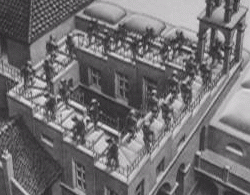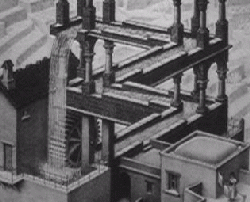

One of the fun aspects of art is that it is not bound by physical reality. What I mean by this is that art, as in the drawing above, can violate our expectations for what is possible quite often to a delightful effect. The drawing above is my attempt at what has been called the impossible trident (Schiffman, 1982). At one end there are three prongs, but at the other end there are only two. Such a figure is called an impossible figure. It is possible, because the depth cues and shape cues of one part of the figure do not have to be consistent with the depth and shape cues of another part of a figure. There are six diagnonal lines. At one end there are circles on them giving the impression of three circular prongs. At the other end the same size lines have cross connecting lines consistent with two square prongs.
M.C. Escher in one artist that often takes advantage of the fredom from physical reality to create some wonderful art. The example below, a detail from "Climbing and Descending" is Escher's version of the always rising or always descending staircase. Once one starts climbing the staircase, one will never reach the top.
Another classic example from M. C. Escher is the 'Waterfall" that replentishes itself. Here, the water goes over the fall and follows a canal that does not appear to rise to a point where it goes over the falls again. On the way down it pushes a water-wheel. A rather neat way to generate some energy!
 Climing and Descending (Kimmen en dalen) (detail) by M. C. Escher |
 Waterfall (Waterval) (detail) by M. C. Escher |